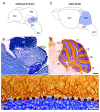Recent advances in understanding the mechanisms of cerebellar granule cell development and function and their contribution to behavior
- PMID: 30109024
- PMCID: PMC6069759
- DOI: 10.12688/f1000research.15021.1
Recent advances in understanding the mechanisms of cerebellar granule cell development and function and their contribution to behavior
Abstract
The cerebellum is the focus of an emergent series of debates because its circuitry is now thought to encode an unexpected level of functional diversity. The flexibility that is built into the cerebellar circuit allows it to participate not only in motor behaviors involving coordination, learning, and balance but also in non-motor behaviors such as cognition, emotion, and spatial navigation. In accordance with the cerebellum's diverse functional roles, when these circuits are altered because of disease or injury, the behavioral outcomes range from neurological conditions such as ataxia, dystonia, and tremor to neuropsychiatric conditions, including autism spectrum disorders, schizophrenia, and attention-deficit/hyperactivity disorder. Two major questions arise: what types of cells mediate these normal and abnormal processes, and how might they accomplish these seemingly disparate functions? The tiny but numerous cerebellar granule cells may hold answers to these questions. Here, we discuss recent advances in understanding how the granule cell lineage arises in the embryo and how a stem cell niche that replenishes granule cells influences wiring when the postnatal cerebellum is injured. We discuss how precisely coordinated developmental programs, gene expression patterns, and epigenetic mechanisms determine the formation of synapses that integrate multi-modal inputs onto single granule cells. These data lead us to consider how granule cell synaptic heterogeneity promotes sensorimotor and non-sensorimotor signals in behaving animals. We discuss evidence that granule cells use ultrafast neurotransmission that can operate at kilohertz frequencies. Together, these data inspire an emerging view for how granule cells contribute to the shaping of complex animal behaviors.
Keywords: Cerebellum; Purkinje cell; behavior; development; granule cell; in vivo electrophysiology.
Conflict of interest statement
No competing interests were disclosed.No competing interests were disclosed.No competing interests were disclosed.No competing interests were disclosed.
Figures



Similar articles
-
Sensorimotor Representations in Cerebellar Granule Cells in Larval Zebrafish Are Dense, Spatially Organized, and Non-temporally Patterned.Curr Biol. 2017 May 8;27(9):1288-1302. doi: 10.1016/j.cub.2017.03.029. Epub 2017 Apr 20. Curr Biol. 2017. PMID: 28434864
-
Functional Outcomes of Cerebellar Malformations.Front Cell Neurosci. 2019 Oct 4;13:441. doi: 10.3389/fncel.2019.00441. eCollection 2019. Front Cell Neurosci. 2019. PMID: 31636540 Free PMC article. Review.
-
Insights into cerebellar development and connectivity.Neurosci Lett. 2019 Jan 1;688:2-13. doi: 10.1016/j.neulet.2018.05.013. Epub 2018 May 7. Neurosci Lett. 2019. PMID: 29746896 Free PMC article. Review.
-
New roles for the cerebellum in health and disease.Front Syst Neurosci. 2013 Nov 14;7:83. doi: 10.3389/fnsys.2013.00083. eCollection 2013. Front Syst Neurosci. 2013. PMID: 24294192 Free PMC article. Review.
-
Interactions Between Purkinje Cells and Granule Cells Coordinate the Development of Functional Cerebellar Circuits.Neuroscience. 2021 May 10;462:4-21. doi: 10.1016/j.neuroscience.2020.06.010. Epub 2020 Jun 14. Neuroscience. 2021. PMID: 32554107 Free PMC article. Review.
Cited by
-
Regulation of cerebellar network development by granule cells and their molecules.Front Mol Neurosci. 2023 Jul 14;16:1236015. doi: 10.3389/fnmol.2023.1236015. eCollection 2023. Front Mol Neurosci. 2023. PMID: 37520428 Free PMC article. Review.
-
The Primary Ciliary Deficits in Cerebellar Bergmann Glia of the Mouse Model of Fragile X Syndrome.Cerebellum. 2022 Oct;21(5):801-813. doi: 10.1007/s12311-022-01382-8. Epub 2022 Apr 19. Cerebellum. 2022. PMID: 35438410 Free PMC article.
-
Reduced Cerebellar BDNF Availability Affects Postnatal Differentiation and Maturation of Granule Cells in a Mouse Model of Cholesterol Dyshomeostasis.Mol Neurobiol. 2023 Sep;60(9):5395-5410. doi: 10.1007/s12035-023-03435-3. Epub 2023 Jun 14. Mol Neurobiol. 2023. PMID: 37314654 Free PMC article.
-
Single-cell transcriptomes reveal molecular specializations of neuronal cell types in the developing cerebellum.J Mol Cell Biol. 2019 Aug 19;11(8):636-648. doi: 10.1093/jmcb/mjy089. J Mol Cell Biol. 2019. PMID: 30690467 Free PMC article.
-
SMO-M2 mutation does not support cell-autonomous Hedgehog activity in cerebellar granule cell precursors.Sci Rep. 2019 Dec 23;9(1):19623. doi: 10.1038/s41598-019-56057-y. Sci Rep. 2019. PMID: 31873117 Free PMC article.
References
Publication types
MeSH terms
Grants and funding
LinkOut - more resources
Full Text Sources
Other Literature Sources

